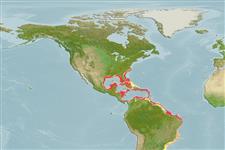Environment: milieu / climate zone / rango de profundidad / distribution range
Ecología
marino asociado a arrecife; rango de profundidad 3 - 213 m (Ref. 5222), usually 3 - 35 m (Ref. 40849). Subtropical; 37°N - 30°S, 98°W - 30°W (Ref. 89707)
Western Atlantic: North Carolina, USA to Rio de Janeiro, Brazil, including the Gulf of Mexico and the Caribbean.
Tamaño / Peso / Age
Madurez: Lm ? range ? - ? cm
Max length : 91.0 cm TL macho / no sexado; (Ref. 7251); common length : 50.0 cm TL macho / no sexado; (Ref. 5217); peso máximo publicado: 10.0 kg (Ref. 5222)
Espinas dorsales (total) : 11; Radios blandos dorsales (total) : 18 - 20; Espinas anales: 3; Radios blandos anales: 8 - 10. Distinguished by the following characteristics: body and fins black with many large white blotches (Ref. 13608). Compressed, with a large pectoral fin; scales smooth (Ref. 26938); greatest depth of body 2.2-2.5 in SL; body width 2.2-2.9 times in depth; head length 2.5-2.8 times in SL; rounded preopercle, finely serrate, serrae at the angle slightly enlarged (Ref. 089707).
Body shape (shape guide): short and / or deep; Cross section: compressed.
Usually on deep ledges, at depths to 210 m and on reefs, usually in caves or deep crevices (Ref. 7251). Solitary (Ref. 26340) and secretive, darts away when approached or frightened (Ref. 9710). Rarely seen in markets. Major threat to this species is fishing pressure (Ref. 089707).
Life cycle and mating behavior
Madurez | Reproducción | Puesta | Huevos | Fecundidad | Larva
Heemstra, P.C. and J.E. Randall, 1993. FAO Species Catalogue. Vol. 16. Groupers of the world (family Serranidae, subfamily Epinephelinae). An annotated and illustrated catalogue of the grouper, rockcod, hind, coral grouper and lyretail species known to date. Rome: FAO. FAO Fish. Synop. 125(16):382 p. (Ref. 5222)
IUCN Red List Status (Ref. 130435: Version 2025-1)
Threat to humans
Harmless
Human uses
Pesquerías: escaso valor comercial; pesca deportiva: si
Herramientas
Special reports
Download XML
Fuentes de Internet
Estimates based on models
Preferred temperature (Referencia
123201): 23.6 - 28, mean 26.7 °C (based on 502 cells).
Phylogenetic diversity index (Referencia
82804): PD
50 = 0.6250 [Uniqueness, from 0.5 = low to 2.0 = high].
Bayesian length-weight: a=0.00871 (0.00484 - 0.01566), b=3.14 (2.98 - 3.30), in cm total length, based on LWR estimates for this species & (Sub)family-body (Ref.
93245).
Nivel trófico (Referencia
69278): 4.5 ±0.80 se; based on food items.
Resiliencia (Referencia
120179): Bajo, población duplicada en un tiempo mínimo de 4.5-14 años (Preliminary K or Fecundity.).
Fishing Vulnerability (Ref.
59153): High vulnerability (56 of 100).
🛈
Nutrients (Ref.
124155): Calcium = 12.2 [6.0, 27.3] mg/100g; Iron = 0.421 [0.213, 0.872] mg/100g; Protein = 18.9 [16.9, 20.7] %; Omega3 = 0.179 [0.098, 0.340] g/100g; Selenium = 24.1 [10.0, 51.5] μg/100g; VitaminA = 48 [11, 248] μg/100g; Zinc = 0.418 [0.261, 0.666] mg/100g (wet weight);
